A creamy and aromatic Thai Panang Curry made with juicy chunks of chicken, crushed peanuts and a sweet Thai yellow curry paste. The spice in this Thai panang curry is balanced out with cool yogurt and sweet coriander, and it can be ready and on the table in just 30 minutes.
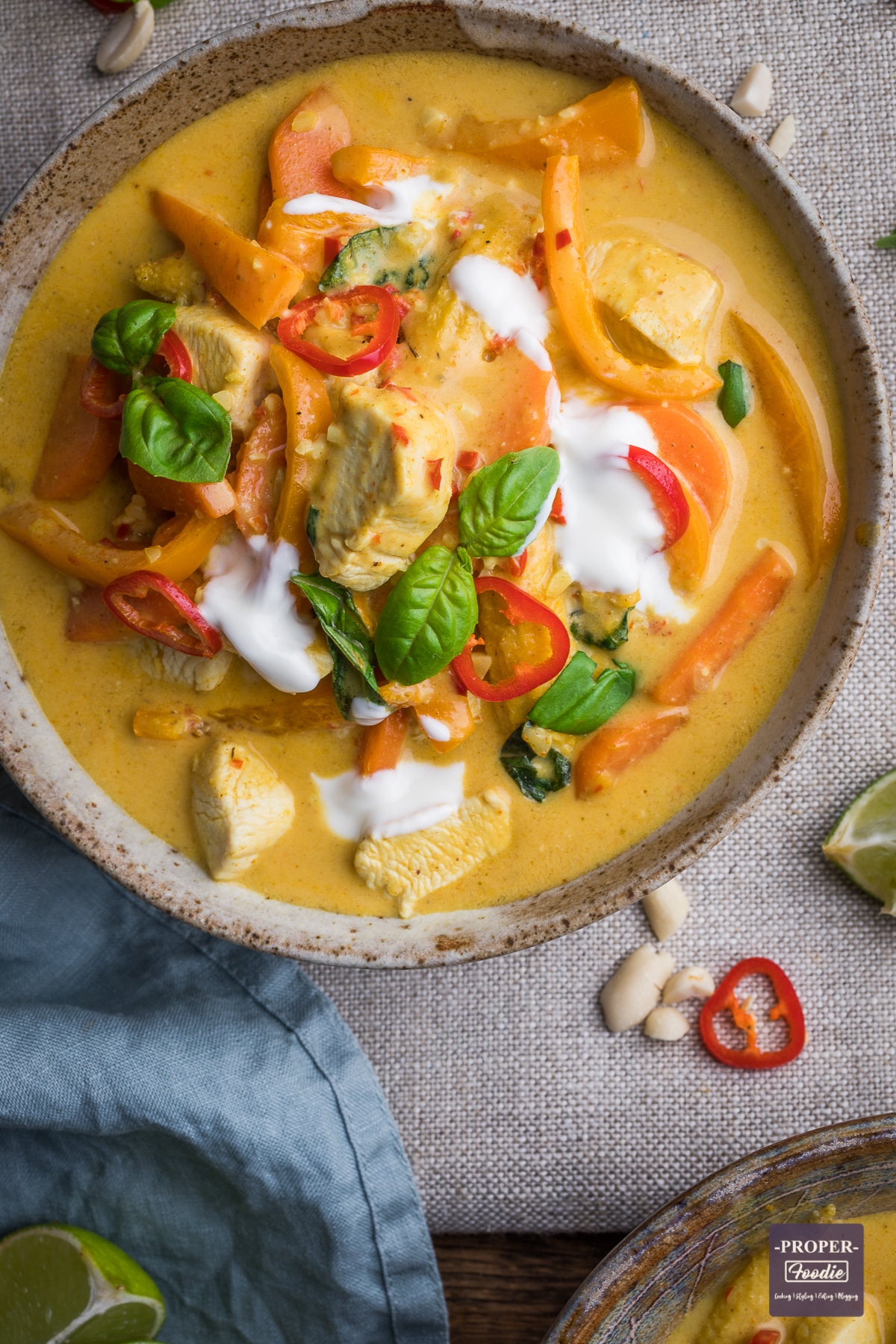
👩🏻🍳 Why make this recipe
Thai panang Curry is milder and sweeter than both red and green curry but it still keeps a deliciously creamy and complex flavour. This is thanks to the use of extra ingredients including ground coriander and crushed peanuts. Whats more, these simple additions are easy to get hold of in the shops, so this chicken panang curry is really easy to replicate at home.
This Thai panang curry recipe is adapted from the Thai recipes I made in 2012 in Thailand when attending the Siam Rice cookery school in Chang Mai, Northern Thailand. I've closely match ingredients where I can and used pre ground spices.
🥘 Ingredients
To make this easy Thai panang curry you will need:
- 1 tablespoon olive oil
- 600g chicken breast cubed
- 2 carrots peeled and sliced into semi circles (260g)
- 2 orange bell peppers sliced (300g)
- 150g baby corn sliced in half length ways
- 1 red chilli pepper finely chopped 15g
- 2 tablespoon Thai yellow curry paste (homemade or from a jar)
- 1 tablespoon finely chopped peanuts
- 1 tin full fat coconut milk 400ml
- 1 tablespoon flour
- 1 teaspoon golden caster sugar
- Fish sauce to season
- 2 dried kaffir lime leaves
- Fresh basil leaves, plain yogurt and freshly sliced red chilli pepper to serve (optional)
Ingredient notes
Chicken: The chicken can be substitute for your preferred meat or fish. Try with white chunky fish instead, such as cod, haddock or hake.
Carrots, bell peppers and corn: Substitute for your preferred veg. I found that the flavour and colour of these particular veg work really well in panang curry.
Thai yellow curry paste: For best results I recommend making the Thai yellow curry paste yourself. However, if you don't have time to make the paste the best alternative is to buy a jar of pre-made paste. Bear in mind that the homemade paste can be made in advance and kept in the fridge for up to a week or frozen for up to 3 months.
Peanuts: Replace with your preferred type of nut (try with cashews for a creamier flavour) or leave out all together.
Coconut milk: The best replacement for coconut milk in terms of consistency and flavour is cream. This can be a little heavy so you can also use yogurt or milk. If using milk I would recommend adding flour as well, as described in the recipe, to help keep the sauce thick.
Flour: The flour is used in this recipe as a thickening agent. If you prefer a curry sauce with a thin consistency or if you are making a gluten free version then leave this out. See expert tips below for alternative ways to thicken a curry sauce.
Fish sauce: Fish sauce is the main seasoning ingredient in Thai cooking and completely transforms the dish. I highly recommend using fish sauce in this recipe for the best flavour. If you can't get hold of any or if you are making a vegetarian curry, you can substitute with soy sauce, Worcestershire sauce or seaweed paste.
🔪 Step by step instructions
- Heat ½ tablespoon olive oil in a large shallow pan or wok on a medium heat. Add the chicken and stir fry for a few minutes until browned all over. Remove the chicken and set to one side.
- Return the pan to the heat and add the remaining ½ tablespoon olive oil. Then add the chopped carrot, bell pepper, baby corn and finely chopped red chilli. Pan fry for a couple of minutes then remove and set to one side along with the browned chicken.
- Place the pan back on the heat. Add the 2 tablespoon of Thai yellow curry paste and 1 tablespoon of finely chopped peanuts. Stir the peanuts into the paste as it heats. Cook the paste and nuts for 1-2 minutes to allow the flavours to release.
- Next pour the coconut milk over the paste and stir well to combine into a yellow curry sauce.
- Heat the sauce gently (do not boil) whilst adding 1 teaspoon sugar, 2 kaffir lime leaves and a good shake of fish sauce (to taste).
- Next, in a small bowl or ramekin, add a little water to the tablespoon of flour and stir into a loose paste. Pour the paste into the curry. Keep heating the sauce and continue to stir allowing it to thicken.
- Once thickened return the chicken and veg to the sauce and stir well.
- Bring the curry to a gentle simmer then place on a lid and continue to simmer gently for 10 minutes or until chicken is cooked through. When the chicken is cooked remove the lime leaves and serve with plain yogurt, fresh basil leaves and sliced red chillies.
💭 Expert tips
Vegetarian option: For a vegetarian option replace the chicken with extra veggies and remember to replace the fish sauce with either soy sauce, Worcestershire sauce or seaweed paste.
Extra spiciness: If you like your Thai curry spicy then add chopped, fresh green chillies during cooking or as a topping. Taste the chillies first so you have a rough idea of how much heat you're adding. Use the smaller, thinner finger chillies for extra heat or use the larger green chillies for a milder flavour.
How to make curry sauce thicker: Use full fat coconut milk in the recipe. The reduced fat versions are more watery and so will ultimately thin out the sauce. Coconut milk can also lose its consistency when boiled rapidly over a prolonged period. So even though reducing a sauce does thicken it, rapidly boiling in this instance will not help.
Other options for thickening the Thai green curry sauce include: Add full fat yogurt to the sauce. Instead of serving rice at the side, mix it directly into your curry whilst still in the pan. If adding vegetables that release water during cooking (e.g. courgettes, mushrooms) roast these in the oven first and then mix into the finished curry. Or add flour to the curry. To avoid flour lumps forming I usually mix 1 tablespoon of flour with a bit of water to form a paste. Then add the flour paste to the curry and mix well.
❓ Frequently asked questions
2-3 tablespoon of paste is usually enough when making a curry for 2-4 people.
Once made, allow the Thai green curry to completely cool then transfer to a sealable container and keep in the fridge for 2 days or or in the freezer for up to 3 months. Defrost in the fridge overnight. Reheat in a pan or in the microwave until piping hot throughout.
Yes its gluten free, as long as you don't use the above flour option for thickening. But do always check the packets of the individual ingredients you are using. Generally the main ingredients in this curry are naturally gluten free.
I usually serve Chicken Panang curry with plain yogurt, fresh basil leaves and freshly sliced chilli. A squeeze of lime juice would also work really well. In addition, there are a number of side dishes you could serve up as well including basmati rice, coconut rice, pilau rice and spring rolls.

🍛 Other Thai curry recipes:
If you've tried this recipe, let me know what you think by leaving a star rating in the recipe card or comment section below. I always appreciate your feedback! You can also follow me on Pinterest, Facebook or Instagram or Sign up to my email list!
📖 Recipe
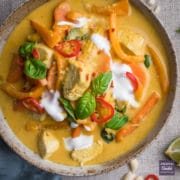
📋 Chicken Panang curry
Equipment
- Large shallow frying pan or wok
- Small dish or ramekin
- 2 medium bowls for setting aside chicken and veg once fried off in the pan
Ingredients
- 1 tablespoon olive oil
- 600 g chicken breast cubed
- 250 g carrots peeled and sliced into semi circles
- 300 g orange bell peppers sliced
- 150 g baby corn sliced in half length ways
- 1 red chilli pepper finely chopped
- 2 tablespoon yellow curry paste homemade or from a jar
- 1 tablespoon finely chopped peanuts
- 400 ml tin full fat coconut milk
- 1 tablespoon flour
- 1 teaspoon golden caster sugar
- 1 teaspoon Fish sauce to season
- 2 dried kaffir lime leaves
To serve:
- Fresh basil leaves
- Plain yogurt
- Freshly sliced red chilli pepper
Instructions
- Heat ½ tablespoon olive oil in a large shallow pan or wok on a medium heat. Add the chicken and stir fry for a few minutes until browned all over. Remove the chicken and set to one side.
- Return the pan to the heat and add the remaining ½ tablespoon olive oil. Then add the chopped carrot, bell pepper, baby corn and finely chopped red chilli. Pan fry for a couple of minutes then remove and set to one side along with the browned chicken.
- Place the pan back on the heat. Add the 2 tablespoon of Thai yellow curry paste and 1 tablespoon of finely chopped peanuts. Stir the peanuts into the paste as it heats. Cook the paste and nuts for 1-2 minutes to allow the flavours to release.
- Next pour the coconut milk over the paste and stir well to combine into a yellow curry sauce.
- Heat the sauce gently (do not boil) whilst adding 1 teaspoon sugar, 2 kaffir lime leaves and a good shake of fish sauce (to taste).
- Next, in a small bowl or ramekin, add a little water to the tablespoon of flour and stir into a loose paste. Pour the paste into the sauce. Keep heating the sauce and continue to stir allowing it to thicken.
- Once thickened return the chicken and veg to the sauce and stir well.
- Bring the curry to a gentle simmer then place on a lid and continue to simmer gently for 10 minutes or until chicken is cooked through.
- When chicken is cooked remove the lime leaves and serve the curry with plain yogurt, fresh basil leaves and sliced red chillies.

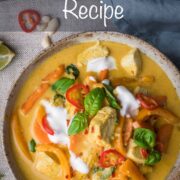
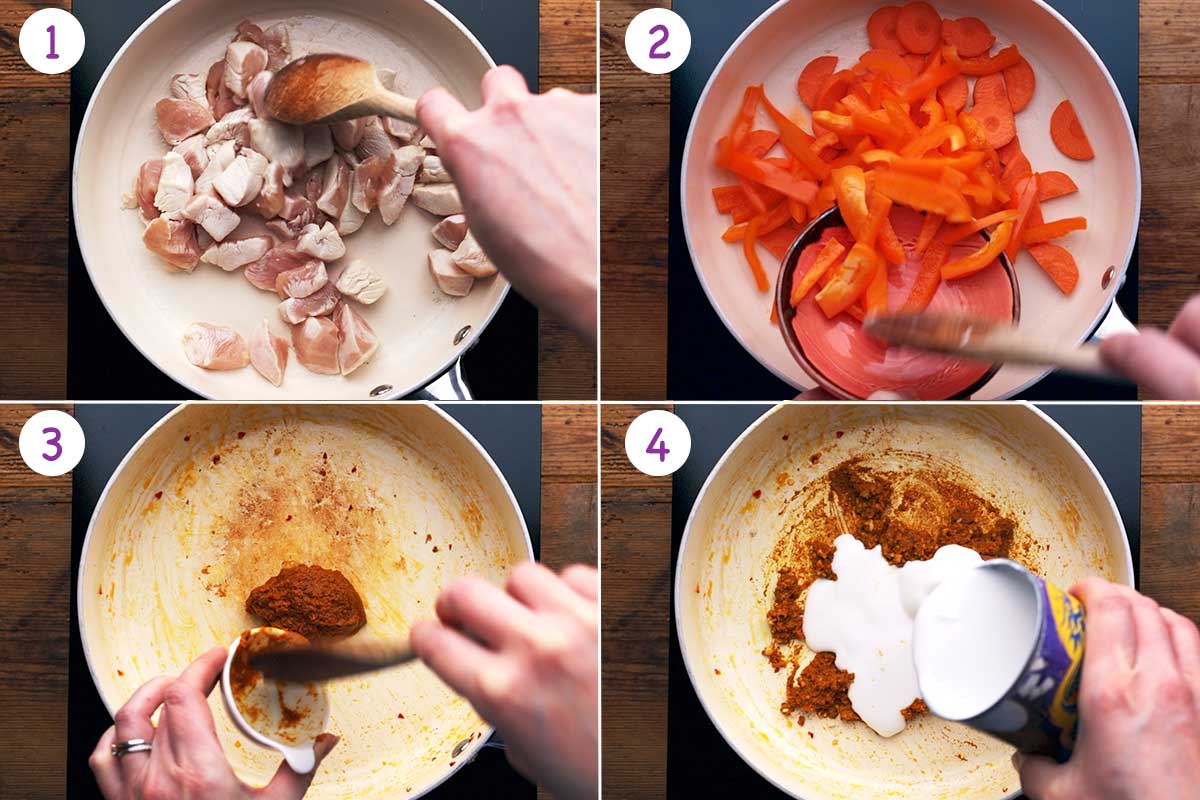
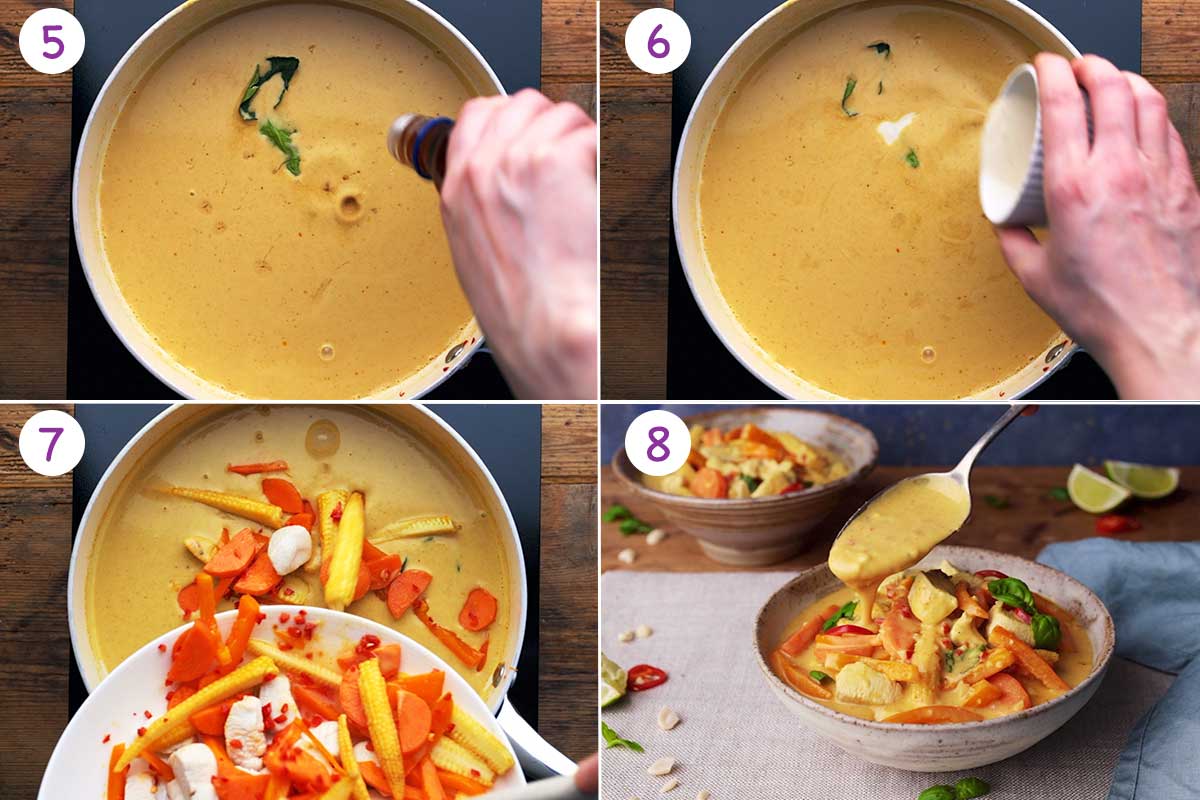
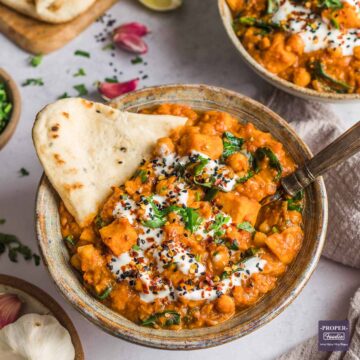
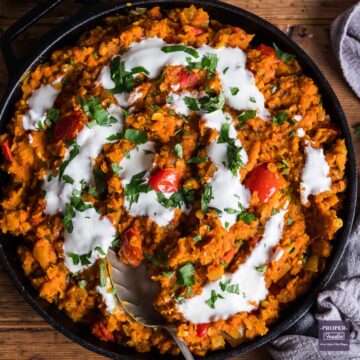
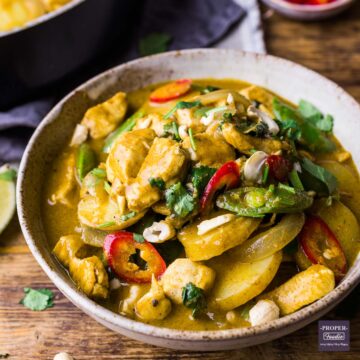
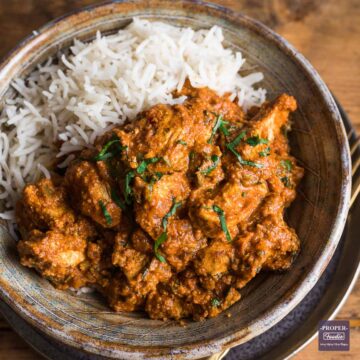
Leave a Reply